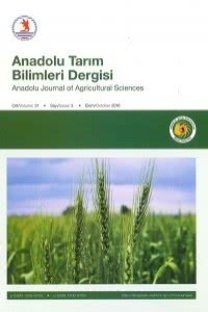Genetik yapısı değiştirilmiş organizmalar: I. Bitkiler
Biyoteknolojideki gelişmeler sayesinde bir organizmadan, diğer organizmalara uygun genlerin aktarması mümkün hale gelmiştir. Bu teknolojiyi mısır ve pamukta olduğu gibi zararlılara dayanıklı ve soyada olduğu gibi herbisitlere dayanıklı çeşitlerin geliştirilmesi için kullanılmıştır. Fakat bugün bu teknoloji, bitki ve hayvanları çok farklı amaçlar yönünde değiştirmek ve geliştirmek için kullanılmaktadır. Bu çalışmaların sonuçlan özellikle son yıllarda yoğun olarak tartışılmaktadır. Bu makalede biyoteknolojik bir yöntem olan gen teknolojisi ile bitkilerde yapılan değişiklikler ele alınacaktır.
Anahtar Kelimeler:
biyoteknoloji, bitkiler, transgenik bitkiler, mısır, pamuk, soya fasulyesi
Genetically modified organisms: 1. Plants
Transfer of suitable genes from one organism to other is possible due to developments in biotechnology. This technology was used for improvement of pathogen resistance in corn and cotton varieties and herbicide resistance in soybean varieties. However, nowadays this technology is used in changing and improvement of plant and animals for different purposes. The results of such investigations were discussed strongly during the last years. In this paper, transformations of plants via biotechnology will be discussed at different dimensions.
Keywords:
biotechnology, plants, transgenic plants, maize, cotton, soyabeans,
___
- Anonymus, 2001. Harvest on the Horizon. Future Issues of the: Agricultural Biotechnology. In: http://pewagbiotech.org/research/harvest/725k.pdf
- Brandt, R, 1995. Transgene Pflanzen. Herstellung, Anwendung, Risiken und Richtlinien. Birkhaeuser. ISBN 3-7643-5202-7 '
- Daele, W., 1987. Kritische Vierteljahresschrift fur Gesetzgeburig und Rechtswissenschaft. 2: 351-366.
- Daniell, H., Streatfield, SI, Wycoff, K., 2001. Medical molecular farming: production of antibodies, biopharrnaceuticais and edible vaccines in plants. Trends in Plant Science 6 (5): 219-226.
- De Kathen, A., 2001. Gene-farming: Stand der Wissenschaft, mögliche RZisiken und Management-Strategien. Gutachten zu spezifische Risiken des Gene-Farming in Pflanzen. Berlin: Umwelbundesamt, texteNr. 15/01.
- Dingermann, T., 1999. Gentechnik, Biotechnik. Lehrbuch und Kompendium für Studium und Praxis. Stuttgart: Wissenschaftliche Verlaggesellschaft GmbH.
- During, K., 2001. Lifescience. http://www.lifescience.de/technologien/03/10.httn
- Elborough, K., 2000. Gren Plastic. Information Systems for Biotechnology. http://www.isb.vt.edu/news/2000/oct00.pdf
- Finkel, E., 1999. Australian Center Develops Tools for the Developing World. Science 285: 1481-1482.
- Gasser, C. S. ve R. T. Fraley., 1992. Scientific American. 266: 62-69.
- Herrchen, M., Kördel, W., 2001. Phytoremediation -Möglichkeiten, Kenntnislücken und Forschungsbedarf im Hinblick auf einen Praxiseinsatz. Ergebnisse und Schlussfolgerungen des Fachgespraeches am 29./30. November 1999 im fraunhofer-İnstitut für Umweltchemie und Okotoxikologie, Schmallenberg. Berlin: Umweltbundesamt (Hrsg.), Texte Nr. 19/01.
- Hoffmann, T., 1997. Gentransfer bei Höheren Pflanzen. In: Biologische Grundlagen der Pflanzenzüchtung. (Werner Odenbach, Hrsg.). Parey Verlag.
- Hoshida, H., Tanaka, Y., Hibino, T., Hayashi, Y., Tanaka, A., Takabe, T. ve T. A. Takabe., 2000. Enhanced Tolerance to Salt Stres in Transgenic Rice that Overexpresses Chloroplast Glutamine Synthetase. In: Plant Molecular Biology 43: 103-111.
- Ibelgaufts, H., 1993. Gentechnologie von A-Z. Studienausgabe. VCH Verlag. James, C. 2004. Preview: Global Status of Commercialized Biotech/GM Crops: 2004. ISAAA Briefs No. 32. ISAAA: Ithaca, NY.Kempken, F. ve R.
- Kempken., 2004. Gentechnik bei Pflanzen. 2. Auflage. Berlin: Springer Verlag.
- Krebbers, E., Falco, S. ve G. Fader., 1999. Modification of Seed Amino Acid and Protein Composition for Feed and Food Application. In: Plant Biotechnology and Food for the 21st Century. Nov.3/4, S. 10.
- Kusnadi, A.R., Nikolov, Z. L. ve J. A. Howard., 1997. Production of Recombinant Proteins in Transgenic Plants: Practical Considerations; Biotechnology and Bioengineering. 56: 473-84, 1997.
- Leemans, J., 1992. Genetic Engineering for Fertility Control. In. Dattee, Y., Dumas, C. And gallias, A., Reproductive Biology and Plant Breeding. 101-106. Springer Verlag, Berlin, Heidelberg, New York.
- Melchers, L. S. ve M. H. Stuiver., 2000. Novel Genes for Diseases Resistance Breeding. In: Current Opinion in Plant Biology 3, S. 147-152.
- Menrad, K., Gaisser, S., Hüsing, B. ve M. Menrad., 2003. Gentechnik in der Landwirtschaft, Pflanzenzucht und Lebensmittelproduktion. TECHNİK, WIRTSCHAFT und POLİTİK. Physica Veriag. ISSSN 1431 -9659
- Moon, B. Y., Higashi, S. I., Gombos, Z. ve N. Murata., 1995. Unsaturation of the Membran Lipids of Chloroplasts Stabilizes the Photosynthetic Machinery Against Low Temperature Photoinhibition in Transgenic Tobacco Plants. In: Proceedings of the National Academy of Sciences of the United States of America 92: 6219-6223.
- Nicholl, D. S. T., 1995. Gentechnische Methoden. Spektrum.
- Öktem, H. A., 2001. Böceklere Dayanıklı Transgenik Bitkilerin Geliştirilmesi. Bitki Biyoteknolojisi : Genetik Mühendisliği ve Uygulamaları. Bölüm 18. Selçuk Üniversitesi Vakfı Yayınlan.
- Robert-Koch-Institut (RKI), 2001. Freisetzen und İnverkerbringen gentechnisch veraenderter Organismen. http://www.rki.de/GENTEC/FREiSETZUNGZEN/FR ZEiSETZ.HTM
- Saedler, H., 2001. Gentechnik in der Pflanzenzüchtung - was ist heute machbar? in: http://www.biologie.uni- hamburg.de/b-online/dO 1_2/hsaedlO 1 .htm
- Sarhan, F. ve J. Danyluk., 2000. Risikoabschaetzung und Nachzulassung-Monitoring Transgener Pflanzen. Sachstandsbericht. TAB-Arbeitsbericht Nr. 68. Berlin: Büro fiir Technikfolgen-Abschaetzung beim Deutschen Bundestag.
- Wenzel, G. ve V. Mohler., 2001. Innovationen in der Pflanzenbiotechnologie. Euro-Biotech 2001: 108-111.
- Willmitzer, L., 1999. Plant Biotechnology: Output Traits. The Second Generation of Plant Biotechnology Products is Gaining Momentum. Current Opinion in Biotechnology 10. 161-162
- Woods, C, 1999. UF Biotech Breakthrough: Alga Gene Boosts Crop Yields. http://www.napa.ufl. edu/99news/alga.htm
- Ye, X., Al-Babili, S., Klöti, A., Zhang, J., Lucca, P., Beyer, P. ve I. Potrykus., 2000. Engineering Provitamin A (b-carotene) Biosynthetic Pathway Into (carotenoid-free) Rece Endosperm. Science, 287: 303-305.
- ISSN: 1300-2988
- Yayın Aralığı: Yılda 3 Sayı
- Başlangıç: 2018
Sayıdaki Diğer Makaleler
Topraklarda kabuk tabakası oluşumu, çeşitleri ve önlenmesi
ALİ TÜRKER, Şevket Büyükhatipoğlu
Bazı mısır çeşitlerinin Orta Karadeniz Bölgesinde performanslarının belirlenmesi
COŞKUN GÜLSER, Feride CANDEMİR
Zekiye COŞKUN, NUTULLAH ÖZDEMİR, Elif ÖZTÜRK
Kök-ur nematodları (Meloidogyne spp.) ile biyolojik mücadele
Erozyona uğramış topraklarda organik atık uygulamalarının bazı mekaniksel özelliklere etkisi
TUĞRUL YAKUPOĞLU, NUTULLAH ÖZDEMİR
Fındık bahçelerinde bulunan zararlı akar türleri ve ekonomik önemleri
